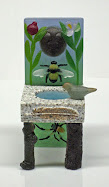The wheel is turning towards fall though you'd never know it based on the temperature. As usual, we down here rely on other indicators that fall is nigh...the shortening days and crop harvest.
Being the born and bred city folk that we are, living out here in an agricultural community has been very interesting and educational. I'm sure the kid that hays the 13 acre field behind us thought we were crazy the first time we saw him do it, standing out there gawking while he mowed, raked and baled. Great entertainment for us and our lesson for the day.
This past weekend it was the cotton in the fields.
I think the farmer that works these fields at the end of our street must have a day job. I only ever see him out there evenings and weekends. Mostly weekends. He started harvesting the cotton Saturday evening working late into the night long after full dark.
field full of cotton (the plants are sprayed with a defoliant a week or two before harvest)
these small harvesters scoop up the cotton leaving what's left of the plant behind
when the harvester is full it disgorges it's contents into a container where it is compressed
and then ejected somehow leaving a giant bale of cotton ready to be loaded up on a truck and carted off
After all the cotton is scooped up, another device goes over the fields cutting the stalks of the plants a couple of inches above ground level. I don't know what they do with those but they weren't left on the ground.
At some point what's left will be plowed under.
And that's your lesson for the day.
One of the first years after we bought the country house but before we were living out here full time, the grandkids were with us for the weekend. It was August, the cotton had popped and driving by on our way over to my sister's house to see her and the chickens somehow we were having a conversation about slavery. Oh oh! They had learned about that in school (they were still in elementary school then).
Later in the day, I took them over to the edge of the cotton field in the middle of the hot hot sun day. Standing there on the edge of the field that went on as far as they could see, full of cotton I told them this:
That had they been a slave in this country they would never have enough to eat and would always be hungry.
That the food they did get would be the cheapest and least quality available.
That they would be barefoot and dressed in rags, clothing no one else wanted.
That they would live in a hut with a dirt floor.
That they would own nothing, not even their children.
That they would have to get up at dawn and work in the fields til dark every day of their lives.
That they would have to carry a gunney sack and pick every bit of this cotton by hand in the hot sun hour after hour and day after day and if they did not work fast enough or long enough they would get a beating.
That they might get the beating anyway.
Standing there on the edge of that field in the hot hot sun in the middle of August looking at all that cotton, I could see in their faces that right then, they got it. You could see the enormity in their eyes.
And that was their lesson for the day.














That's a good lesson. But I think, sitting here in the air-conditioning, a thousand miles from that field, it's not the same.
ReplyDeleteBut thanks anyway.
You are truly the best grandmother on earth, you really are!
ReplyDeleteI had a friend who spent a summer in the early 1970s in Mississippi picking cotton. She said it was miserable work, far more difficult than picking fruit, something she did routinely in the summer.
Thanks for the lessons! I always love learning something new.
what a wonderful post.
ReplyDelete1st, i've never seen cotton being harvested so i enjoyed it.
2nd, what a great way to make a permanent impression on young minds...
I have picked cotton. It is not an easy task, dragging the cotton sack down rows and rows and rows of cotton. Cotton boles have sharp places on the husks. Our fingers are poked and bleeding. The canvas sack is long, with length being longer than the width, with a wide strap to place across your chest. I think I remember I had a small sack about four feet long. One end was gathered with a rope and the other end open to place your cotton in. When your sack was full, you cinch the other end and carry it to the wagon and empty it...with both ends open, the ease of emptying is greater. When the wagon was full, it was taken to a cotton gin and baled there. You got paid by the weight of the cotton.
ReplyDeleteMike's dad picked cotton some in his youth. It really is terrible work. I could never even imagine having to do that - I hated to pick strawberries in the garden!
ReplyDeleteWhat a mind opening lesson presented to just the right audience. Yay for you grandma. That's what grandmothering should be about...passing along the kind of lessons that you remember all of your life, the ones laced with love of not only the now but the future.
ReplyDeleteI applaud your love.
Oma Linda
Good lessons, Miss Ellen.
ReplyDeleteEven into the late 1950s black people picked cotton where I grew up in Georgia. A vivid memory is of me sitting at the kitchen table looking out the screen door to see Negroes layered in old clothes (long skirts and pants, long-sleeved shirts, heads wrapped in bandanas with straw hats atop their heads) climbing into the back of a pick-up truck or flatbed trailer and headed to the fields. Finally, after the Civil Rights movement began white farmers of means began to buy equipment to do the work. I'm sure this meant many unemployed black people scrambling for some kind of work.
Reya doesn't say whether her friend is white or of color, nor what the circumstances were for her picking cotton; that could be yet another lesson.
wonder what's in the spray - When My folks moved to south Texas they stood out in the field often, watching the crop dusters , fascinated by their low swoops and clouds of spray - poetic...later they suffered complications from their mesmerized curiosity.
ReplyDeleteSo agree with Reya- you are the absolute best G-ma EVER!
Great pics and post! What a good lesson for the grandchildren.
ReplyDeleteThose are indeed good points for your grandchildren, and the cotton machines doing the picking--that is pretty cool. Maybe your neighbor picks in the evenings because it is cooler. Plus, he probably does work another job.
ReplyDeleteMy parents also picked cotton as kids. One was Caucasian and the other Caucasian/Indian. Their families worked as share croppers and were both dirt poor. This is true for most of SE Oklahoma families in the 1930's. Maybe Texas also?
The kids could have heard a teacher talk until her/his tongue got tired and never got the lesson they received at the edge of that cotton field.
ReplyDeleteThat is an old combine. It had to be a hard task to do by hand.i have never seen them harvest it and would have stood as you did watching.It is fun to watch the Amish nearby using nonmechanical means to farm.
ReplyDeleteYou're a fine teacher, Ms. Abbott.
ReplyDeletegood on you
ReplyDeletea wonderful lesson to make the grankids more empathetic and aware
I never realized how pretty a cotton field is right before harvest
I love your photos
I was going to say: where has all the romance of farm labouring gone what with the machinery used in modern times.
ReplyDeleteAfter I'd read on, I changed my mind.
Lesson well learned.
came back to say, congrats on your POTW!
ReplyDeleteGreat lesson, pics, post, and blog. A brilliant combo. Thank you.
ReplyDeleteI found both lessons very valuable. I just saw some cotton fields in Mississippi the other day and wondered when they would be bailed. Interesting process. Certainly easier with machines.
ReplyDeleteBetter than book-learning any day! Congrats on POTW.
ReplyDelete